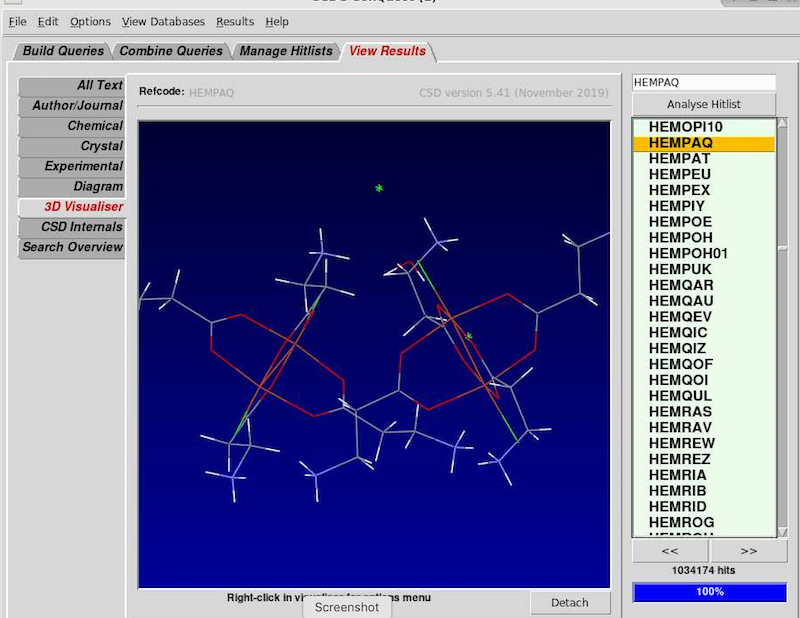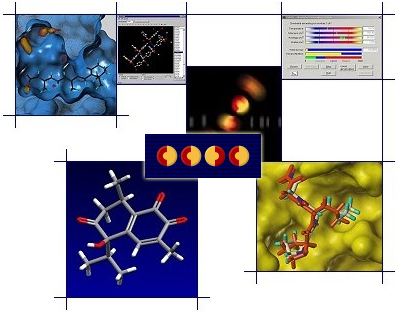


The Cambridge Structural Database is the world repository of small molecule crystal structures. The database holds bibliographic, 2D chemical and 3D structural results from crystallographic analyses of organics, organometallics and metal complexes. Both X-ray and neutron diffraction studies are included for compounds containing up to ca. 500 atoms (including hydrogens). NOTE: The database is NOW available on the biowulf cluster.
Along with the database are tools for search, retreival, analysis, and display of the CSD contents. These include ConQuest (for text, numeric, 2D substructure and 3D geometric searching) and VISTA (statistical analysis and display of geometric and other data).
Installers for Windows, Mac and Linux OSes, are also available for all NIH employees interested in using the software. If you would like to use CSD from your local desktop, please contact staff@hpc.nih.gov, for a link to the download.
NIH users can access the CSD directly via the WebCSD portal. New structures are added weekly for up-to-date searches. Users can perform searches - Similarity, Substructure, Text and Numerical - as well as browse the database. The portal is restricted to NIH IP addresses only. If you are at home, you must connect to the NIH VPN before using.
This application requires a graphical connection.
To use, type module load CSD, then quest&, at the prompt.
Sample session: (replace 'username' with your own Helix/Biowulf username).You cannot run Conquest on the Biowulf login node. You will first need to allocate an interactive session with 'sinteractive'.
[user@biowulf]$ sinteractive salloc.exe: Pending job allocation 46116226 salloc.exe: job 46116226 queued and waiting for resources salloc.exe: job 46116226 has been allocated resources salloc.exe: Granted job allocation 46116226 salloc.exe: Waiting for resource configuration salloc.exe: Nodes cn3144 are ready for job [user@cn3144 ~]$ module load CSD [user@cn3144 ~]$ quest & Starting ConQuest. Use questv5 for QUEST. Running ConQuest with glibc version 2.5 2.5


Loading the CSD module will also set up the paths for the CSD python API installation. Sample interactive session:
biowulf% sinteractive --mem=20g
salloc.exe: Pending job allocation 46116226
salloc.exe: job 46116226 queued and waiting for resources
salloc.exe: job 46116226 has been allocated resources
salloc.exe: Granted job allocation 46116226
salloc.exe: Waiting for resource configuration
salloc.exe: Nodes cn3144 are ready for job
[user@cn3144 ~]$ module load CSD
[+] Loading Cambridge Structural Database 2020 on cn0931
# Note: the following is required to run without an Xwindows display
# but will prevent diagram generation and other graphics-oriented
# pieces of the CSD from running
[user@cn3144 ~]$ export CCDC_PYTHON_API_NO_QAPPLICATION=True
[user@cn3144 ~]$ python
Python 3.7.6 | packaged by conda-forge | (default, Jan 7 2020, 22:33:48)
[GCC 7.3.0] on linux
Type "help", "copyright", "credits" or "license" for more information.
>>> from ccdc import io
QStandardPaths: XDG_RUNTIME_DIR not set, defaulting to '/tmp/runtime-user'
>>> csd_reader = io.EntryReader('CSD')
>>> cryst_abebuf = csd_reader.crystal('ABEBUF')
>>> mol_abebuf = csd_reader.molecule('ABEBUF')
>>> round(mol_abebuf.molecular_weight, 3)
317.341
>>> mol_abebuf.is_organic
True
>>> print(mol_abebuf.heaviest_component.smiles)
O=C1Nc2ccccc2C(=O)Nc2ccccc12
>>> quit()
[user@cn3144 ~]$ exit
biowulf%
Set up a batch script along the following lines:
#!/bin/bash
module load CSD
# Note: the following is required to run without an Xwindows display
# but will prevent diagram generation and other graphics-oriented
# pieces of the CSD from running
export CCDC_PYTHON_API_NO_QAPPLICATION=True
python << EOF
from ccdc import io
from ccdc.search import TextNumericSearch
csd_reader = io.EntryReader('CSD')
text_numeric_search = TextNumericSearch()
text_numeric_search.add_compound_name('aspirin')
identifiers = [h.identifier for h in text_numeric_search.search()]
for identifier in sorted(set(identifiers)):
e = csd_reader.entry(identifier)
if e.melting_point:
print('%-8s http://dx.doi.org/%-25s %s' % (e.identifier,e.publication.doi,e.melting_point))
EOF
Submit with:
sbatch myscriptThe script should produce an output file containing the following:
[+] Loading Cambridge Structural Database 2020 on cn#### ACMEBZ http://dx.doi.org/10.1107/S0567740881006729 385K ACSALA13 http://dx.doi.org/10.1021/ja056455b 135.5deg.C BEHWOA http://dx.doi.org/10.1107/S0567740882005731 401K CUASPR01 http://dx.doi.org/10.1107/S1600536803026126 above 573 K HUPPOX http://dx.doi.org/10.1039/b208574g 91-96 deg.C HUPPOX01 http://dx.doi.org/None 91-96 deg.C NUWTOP01 http://dx.doi.org/10.1039/c2ce06313a 147 deg.C PIKYUG http://dx.doi.org/10.1021/acs.cgd.8b00718 502 K